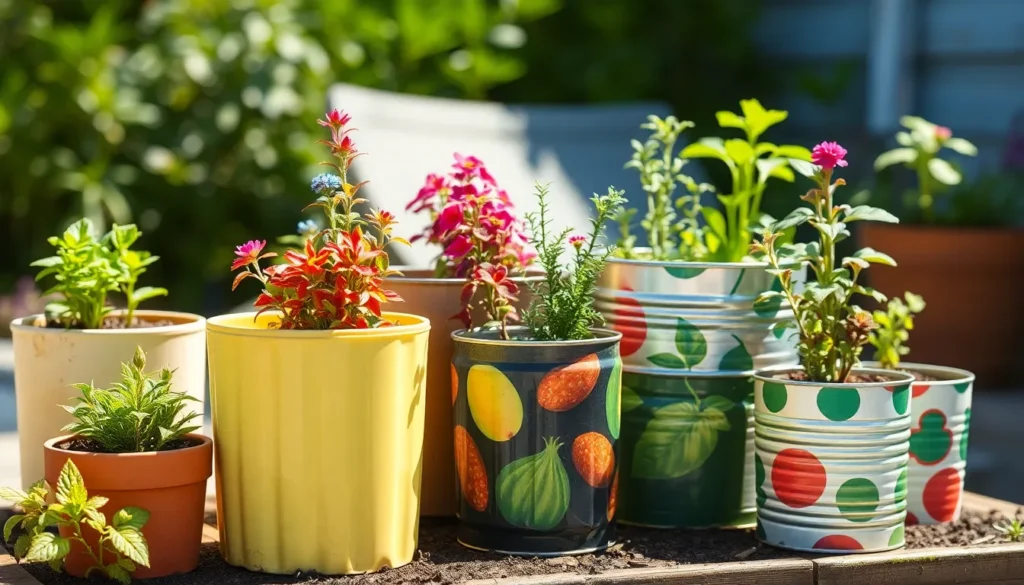We’re living in an era where sustainability meets creativity and recycled pots for plants perfectly embody this beautiful intersection. Eco-conscious gardeners are discovering that some of the most stunning planters don’t come from expensive garden centers – they come from items we’d typically toss in the trash.
From plastic bottles transformed into hanging gardens to old boots repurposed as whimsical herb containers, recycled plant pots offer endless possibilities for both indoor and outdoor spaces. We’ve found that these DIY answers not only reduce waste but also create unique conversation pieces that reflect our personal style.
The best part? Making recycled pots costs virtually nothing while delivering maximum impact for our plants and our planet. Whether we’re dealing with small succulents or larger flowering plants, there’s a recycled container solution that’ll work perfectly for every gardening need.
Benefits of Using Recycled Pots for Plants
Transforming everyday discarded items into plant containers offers remarkable advantages that extend far beyond simple gardening answers. We’ve discovered that recycled pots deliver environmental, financial, and aesthetic benefits that make them an excellent choice for modern gardeners.
Environmental Impact Reduction
Reducing landfill waste becomes achievable when we repurpose containers like yogurt cups, tin cans, and plastic bottles as plant pots. Every recycled container we use prevents one more item from ending up in waste facilities where it could take decades to decompose.
Decreasing manufacturing demand occurs naturally as we choose recycled options over purchasing new plastic or ceramic pots. Manufacturing new containers requires important energy consumption and raw materials that we can avoid entirely through creative repurposing.
Lowering carbon emissions happens when we eliminate the transportation and production processes associated with new pot manufacturing. Our recycled container choices contribute to reducing the overall environmental footprint of our gardening activities.
Conserving natural resources takes place as we divert materials from waste streams and give them new life as functional planters. We’re essentially participating in a circular economy that maximizes the utility of existing materials.
Cost-Effective Gardening Answers
Eliminating pot expenses allows us to allocate more budget toward quality soil, seeds, and plant care essentials rather than expensive containers. We can create dozens of planters using items we already have at home without spending additional money.
Maximizing gardening budgets becomes possible when we invest saved container costs into better fertilizers, tools, or premium plant varieties. Our recycled pot approach can reduce gardening expenses by 60-80% compared to purchasing new planters.
Supporting bulk planting happens easily when we have unlimited access to free containers through household recycling. We can start multiple seedlings, create propagation stations, or expand our garden collection without financial constraints.
Enabling experimental growing occurs when the low cost of recycled containers allows us to try new plant varieties or growing techniques without important financial risk. We can afford to make mistakes and learn through trial and error.
Unique Aesthetic Appeal
Creating personalized garden decor becomes an artistic expression when we transform ordinary containers into customized planters that reflect our individual style. We can paint, decorate, or modify recycled containers to match any design theme or color scheme.
Developing conversation starters happens naturally when guests notice our creative use of unexpected items like colanders, boots, or vintage tins as planters. Our recycled containers often become focal points that showcase both our environmental consciousness and creativity.
Establishing eclectic charm emerges from mixing various recycled container types, sizes, and textures throughout our garden spaces. We create visually interesting displays that have more character than uniform store bought pots.
Showcasing sustainable lifestyle becomes visible to others when our recycled planters demonstrate practical environmental stewardship in action. Our container choices communicate our values while creating beautiful garden spaces that inspire others to adopt similar practices.
Types of Materials Perfect for Recycled Plant Pots
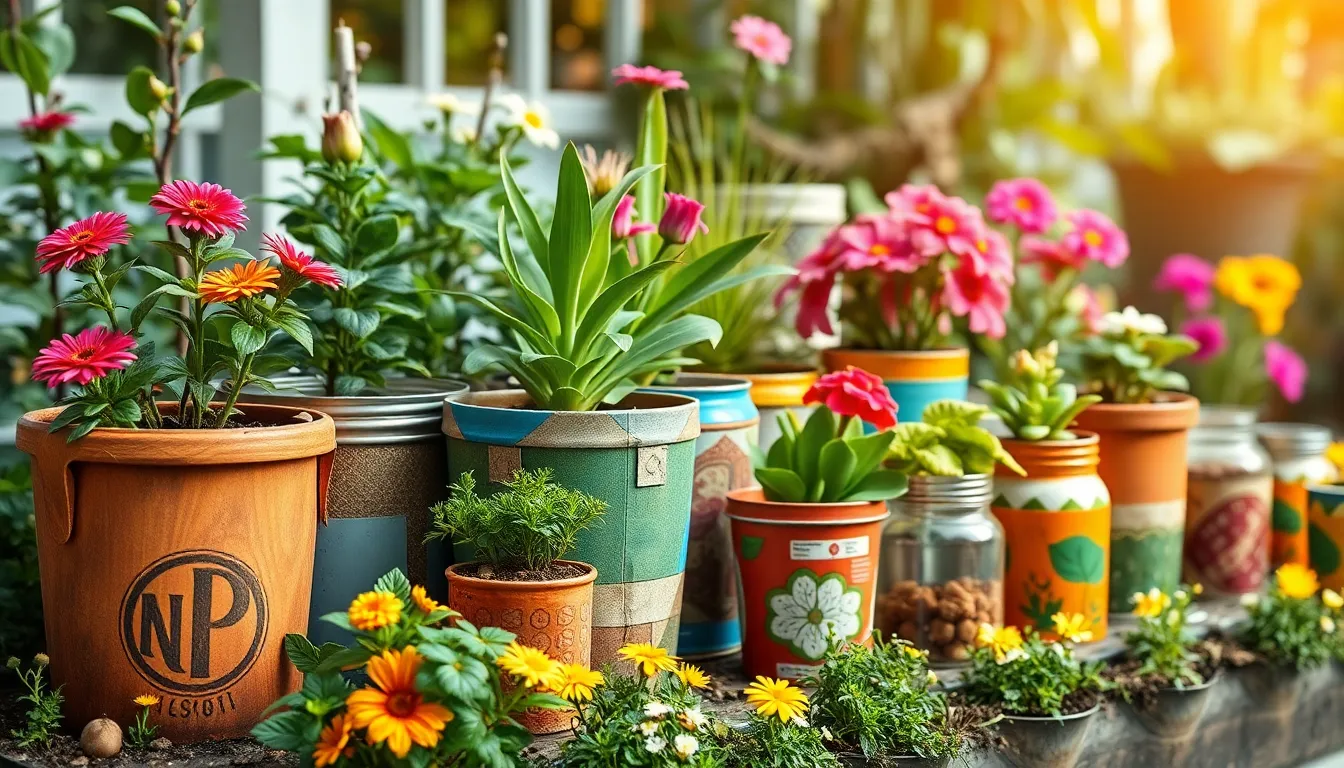
We’ll explore the most effective materials you can transform into eco-friendly planters that benefit both your garden and the environment.
Plastic Containers and Bottles
Plastic containers lead our list of recycled pot materials due to their exceptional durability and plant-friendly properties. These repurposed vessels resist pests and diseases while offering impressive longevity that withstands weather fluctuations throughout multiple growing seasons. Yogurt containers, milk jugs, and detergent bottles become non-porous planters that minimize moisture accumulation where harmful pathogens typically thrive.
Environmental benefits make plastic recycling particularly impactful since we’re diverting waste from landfills and oceans while conserving the resources needed for new plastic production. Advanced designs incorporate built-in water reservoirs that maintain optimal soil moisture levels for healthier plant growth. Replacement frequency drops significantly with these weather-resistant containers, eventually saving both resources and money over time.
Tin Cans and Metal Containers
Metal containers provide robust, long-lasting planters that add rustic charm to any garden setting. Coffee cans, soup tins, and food containers transform into sturdy vessels perfect for herbs, flowers, and small vegetables. Durability stands out as their primary advantage, often lasting for years when properly maintained.
Proper drainage becomes essential with metal recycled pots since water can accumulate and cause root rot without adequate holes. Rust prevention treatments help maintain both the container’s integrity and your plants’ health over extended periods. Industrial-style aesthetics appeal to gardeners seeking unique visual elements that complement modern or farmhouse garden designs.
Cardboard and Paper Products
Cardboard materials excel as temporary planters and seed starters that eventually enrich your soil naturally. Egg cartons, cereal boxes, and paper containers create biodegradable pots perfect for germinating seeds and nurturing young seedlings. These eco-friendly options decompose directly in the ground, eliminating transplant shock while adding organic matter to your garden beds.
Waste reduction reaches its peak with paper products since they completely break down without leaving behind any synthetic residues. Seedling growth benefits from the gradual decomposition process that provides gentle nutrition as roots develop. Short-term use makes them ideal for indoor seed starting before transplanting to permanent outdoor locations.
Glass Jars and Bottles
Glass containers create stunning decorative planters that showcase small plants and succulents beautifully. Mason jars, wine bottles, and food containers become elegant vessels that avoid plastic use entirely while offering complete reusability. Transparency allows us to observe root development and water levels, creating both functional and educational displays.
Weight considerations make glass better suited for stationary indoor arrangements or small outdoor plants rather than large garden installations. Succulent gardens thrive in glass containers due to their lower water requirements and compact growth habits. Aesthetic appeal reaches new heights when we arrange multiple glass planters of varying sizes and shapes throughout our living spaces.
Creative DIY Ideas for Making Recycled Pots for Plants
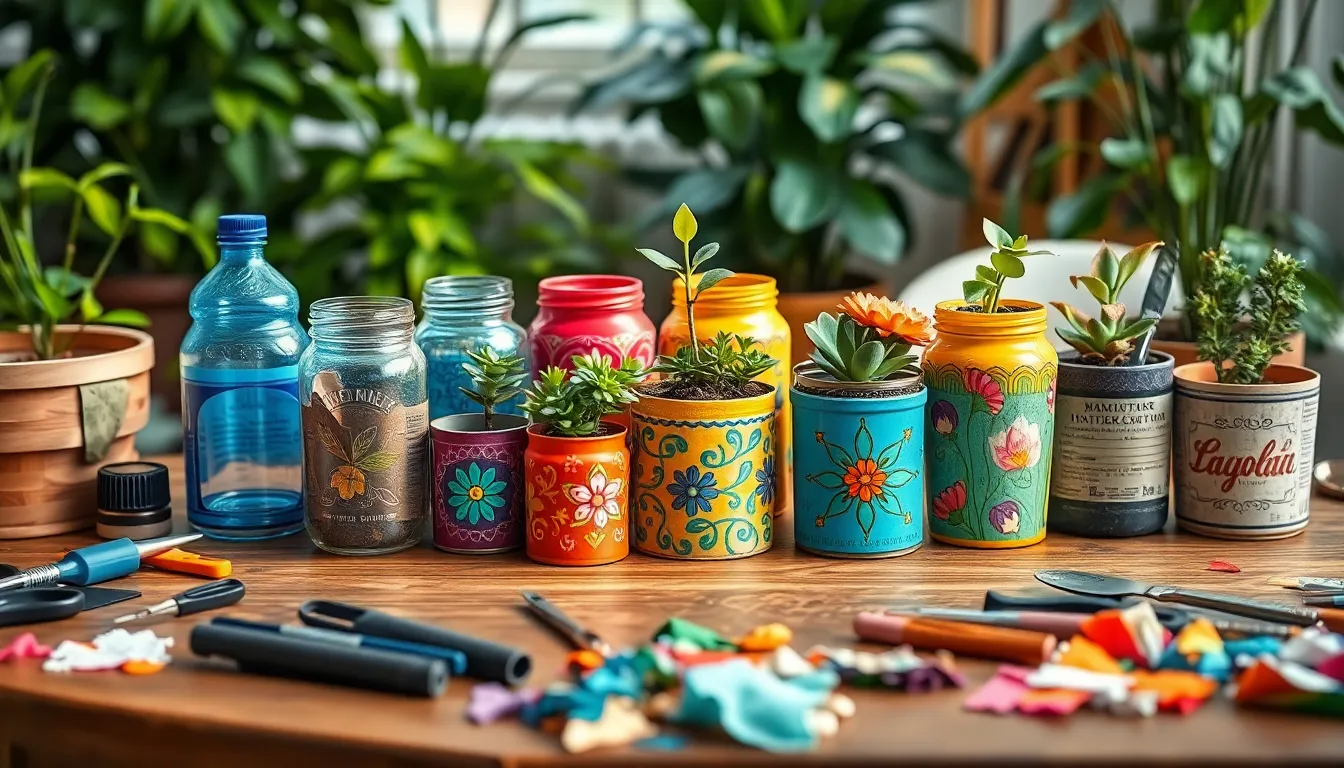
Now that we’ve explored the materials available for recycled plant pots, let’s jump into exact techniques and creative approaches that’ll transform everyday household items into stunning planters.
Upcycling Household Items
Plastic bottles and containers offer endless possibilities for creative plant pot designs. We can cut soda bottles into animal shapes and paint them for personalized planters that children especially love. Ice cream tubs work perfectly for succulents or cacti since their wide opening provides excellent access for plant care.
Old clothing and fabric scraps present unique upcycling opportunities we often overlook. Jean pockets can be attached to boards or frames to create vertical planters that maximize growing space. These fabric gardens add texture and visual interest while keeping our old clothes out of landfills.
Small household items like eggshells serve as biodegradable starter pots for seedlings. We simply crack the top, add soil, and plant seeds directly inside. When it’s time to transplant, the entire eggshell goes into the ground where it decomposes and enriches the soil.
Glass jars and tin cans transform into elegant planters with minimal effort. We clean them thoroughly, add drainage holes, and they’re ready for herbs or small flowering plants. Mason jars work particularly well for kitchen herb gardens.
Decorative Painting and Wrapping Techniques
Opaque matte white paint creates the perfect base for our recycled pot designs. We apply 2 coats with several hours of drying time between applications for maximum durability and coverage. This technique works especially well on plastic containers and tin cans.
Bright colors and patterns help personalize our planters to match any decor style. Colored pencils, markers, or Sharpie pens allow us to add intricate designs, animal motifs, or themed decorations based on our preferences.
Fabric wrapping conceals the original container while adding texture and warmth to our planters. We can use rope, decorative paper, or fabric scraps secured with strong adhesive or ties. This technique particularly enhances tin cans and plastic containers.
Layered decorating approaches combine multiple techniques for sophisticated results. We might start with a painted base, add fabric accents, and finish with rope details around the rim.
Adding Drainage Systems
Proper drainage holes prevent waterlogging and root rot in our recycled containers. We use scissors for plastic containers, drills for harder materials, or nails for puncturing smaller holes. The key is creating multiple holes rather than one large opening.
Elevation techniques improve water flow by lifting our pots slightly off surfaces. Small stones or pot feet allow excess water to escape freely while protecting surfaces from moisture damage.
Base layering systems enhance drainage effectiveness inside our containers. We add gravel or activated charcoal before soil to improve water flow and reduce odors that might develop in enclosed containers.
Strategic hole placement varies depending on container shape and plant needs. Bottom holes are essential, but side holes near the base provide additional drainage for plants that prefer drier conditions.
Best Plants to Grow in Recycled Pots for Plants
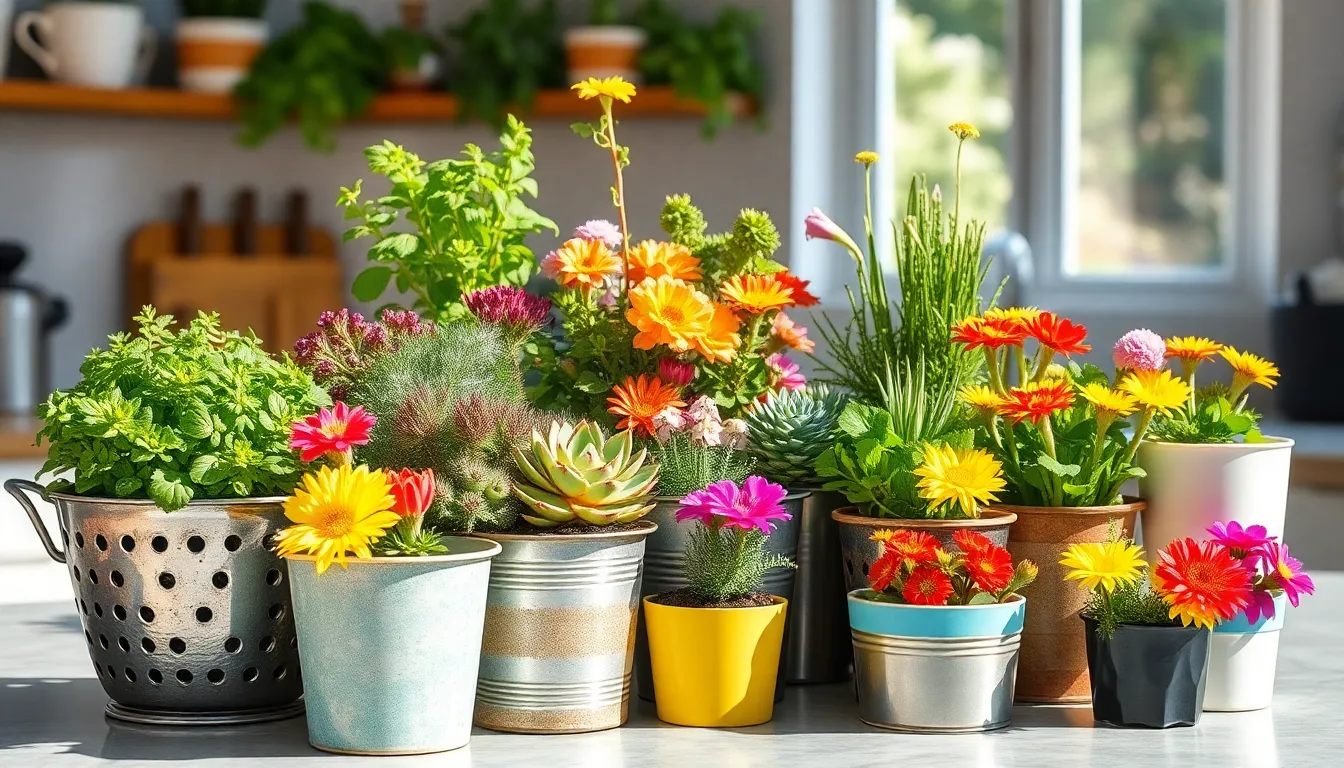
Now that we’ve explored the creative possibilities of recycled containers, let’s discover which plants thrive best in these sustainable planters.
Herbs and Small Vegetables
Basil transforms any recycled container into a fragrant kitchen garden centerpiece. We’ve found that metal colanders work exceptionally well for herbs like basil, oregano, and thyme because their built-in drainage holes prevent waterlogging. Kitchen herbs flourish in these repurposed containers, bringing fresh flavors right to your cooking space.
Small vegetables adapt perfectly to recycled planters when they don’t require deep soil systems. Cherry tomatoes, lettuce, and radishes grow successfully in larger yogurt containers or plastic bottles. These compact vegetables make efficient use of limited container space while providing homegrown produce for your table.
Succulents and Cacti
Succulents excel in recycled pots because they require minimal watering and excellent drainage. We recommend using olive oil cans or tin containers with holes drilled in the bottom for these drought-tolerant plants. Their low water requirements make them forgiving if your recycled container doesn’t retain moisture perfectly.
Cacti bring striking visual appeal to upcycled containers while requiring minimal maintenance. These resilient plants transform simple tin cans into eye-catching displays. Colanders work particularly well for cacti arrangements since their multiple drainage holes prevent the root rot that kills these desert plants.
Indoor Flowering Plants
Flowering plants create vibrant indoor displays when planted in colorful recycled containers. We suggest painting tin cans or spray-coating plastic containers to prevent rust and add visual interest. Marigolds, petunias, and impatiens bring cheerful blooms to repurposed planters throughout your home.
Proper drainage becomes crucial for flowering plants to prevent root diseases and maintain healthy blooms. Always drill drainage holes in solid containers before planting flowering varieties. These plants reward good drainage with longer-lasting flowers and stronger root systems.
Seedlings and Starter Plants
Seedlings thrive in biodegradable recycled containers that can be planted directly into the ground. We’ve discovered that newspaper pots, toilet paper rolls, and egg cartons create perfect nurseries for young plants. These materials decompose naturally while protecting delicate root systems during early growth stages.
Yogurt cups provide excellent temporary homes for seedlings before outdoor transplanting. These clear containers let us monitor root development while protecting vulnerable young plants. Cost-effective seed starting becomes possible when we repurpose these everyday containers instead of buying expensive seed trays.
Starter plants benefit from the controlled environment that recycled containers provide during their vulnerable early weeks. Plastic yogurt cups maintain consistent moisture levels while egg cartons offer individual compartments for different seed varieties. This approach supports healthy plant growth while reducing waste from traditional gardening supplies.
Essential Tips for Preparing Recycled Pots for Plants
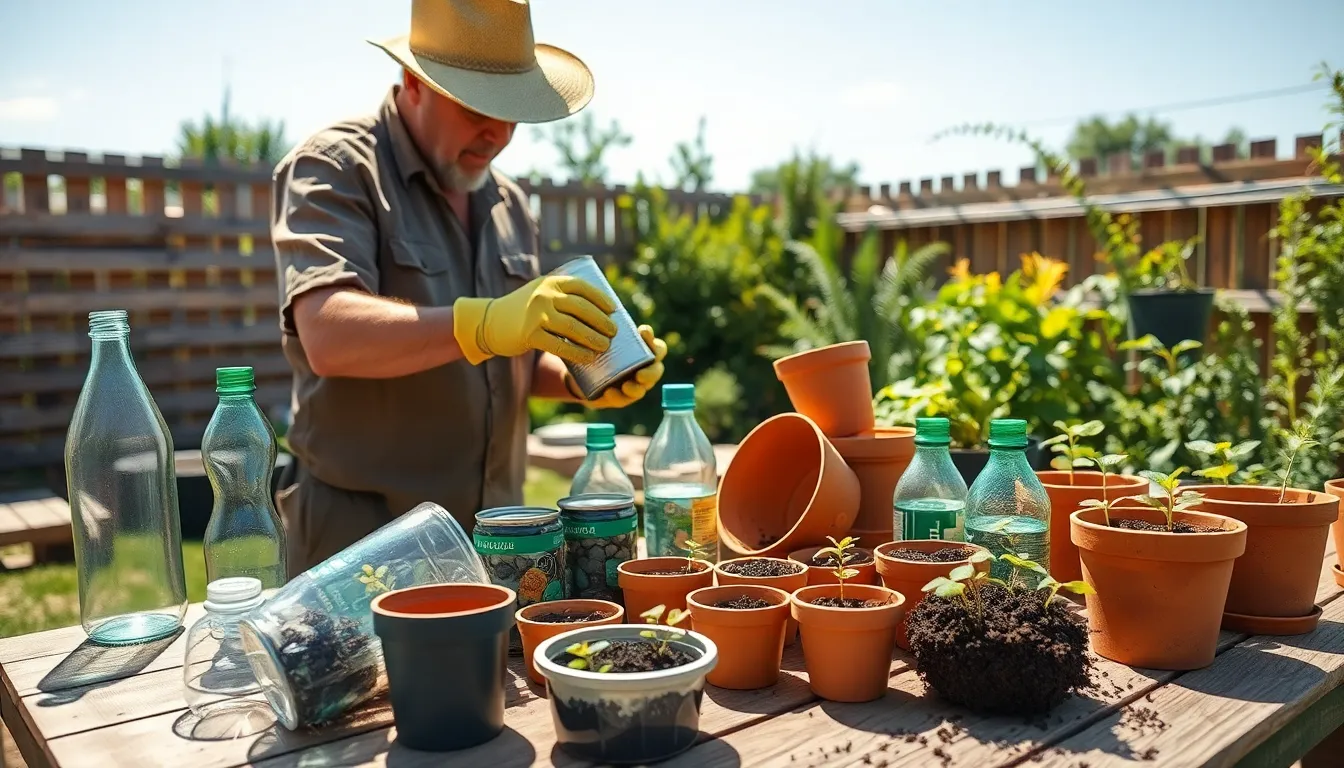
Success with recycled pots depends on proper preparation before planting. We’ll guide you through the essential steps to ensure your repurposed containers provide a healthy growing environment for your plants.
Proper Cleaning and Sanitization
Clean recycled pots thoroughly before using them for your plants. Remove all labels and adhesive residues from tin cans and metal containers, then wash them with warm soapy water and dry completely to prevent contamination or mold growth. Smooth down any sharp edges on metal containers to avoid injury during handling and planting.
Paper-based recycled pots require dry handling to maintain their structural integrity. Ensure these materials are completely free from dirt or contaminants before use. For plastic containers, we recommend using a mild bleach solution to eliminate bacteria and fungi that could harm your plants. Glass jars need special attention to remove any food residues that might attract pests or create unhealthy growing conditions.
Creating Adequate Drainage Holes
Drainage holes are absolutely critical for preventing root rot and maintaining plant health. Poke or drill holes into the bottom of metal cans and cartons using a hammer and nail or drill bit. These holes allow excess water to flow freely, which is essential for healthy root development.
For plastic containers, we suggest creating multiple small holes rather than one large hole to ensure proper water distribution. Cardboard and paper pots often allow natural water movement through their walls, but you may still need to create additional drainage points if the material is too thick. Position drainage holes evenly across the bottom surface to prevent water from pooling in one area.
Size Considerations for Plant Growth
Select recycled pots that match your plant’s root space requirements for optimal growth. Small seeds and seedlings can start in compact containers like paper pots or cut cartons, then be transplanted as they grow. Larger plants need bigger containers with sufficient depth and width to accommodate their expanding root systems.
Consider the mature size of your chosen plants when selecting recycled containers. Herbs like basil require containers at least 6 inches deep, while tomatoes need pots that are 12 inches or larger in diameter. Leave approximately 1-2 inches of space at the top of each pot to prevent soil spillage during watering and to allow room for growth. Match container depth to your plant’s root type—shallow-rooted plants like lettuce work well in wide, shallow containers, while deep-rooted plants like carrots need tall, narrow pots.
Safety Considerations When Using Recycled Pots for Plants
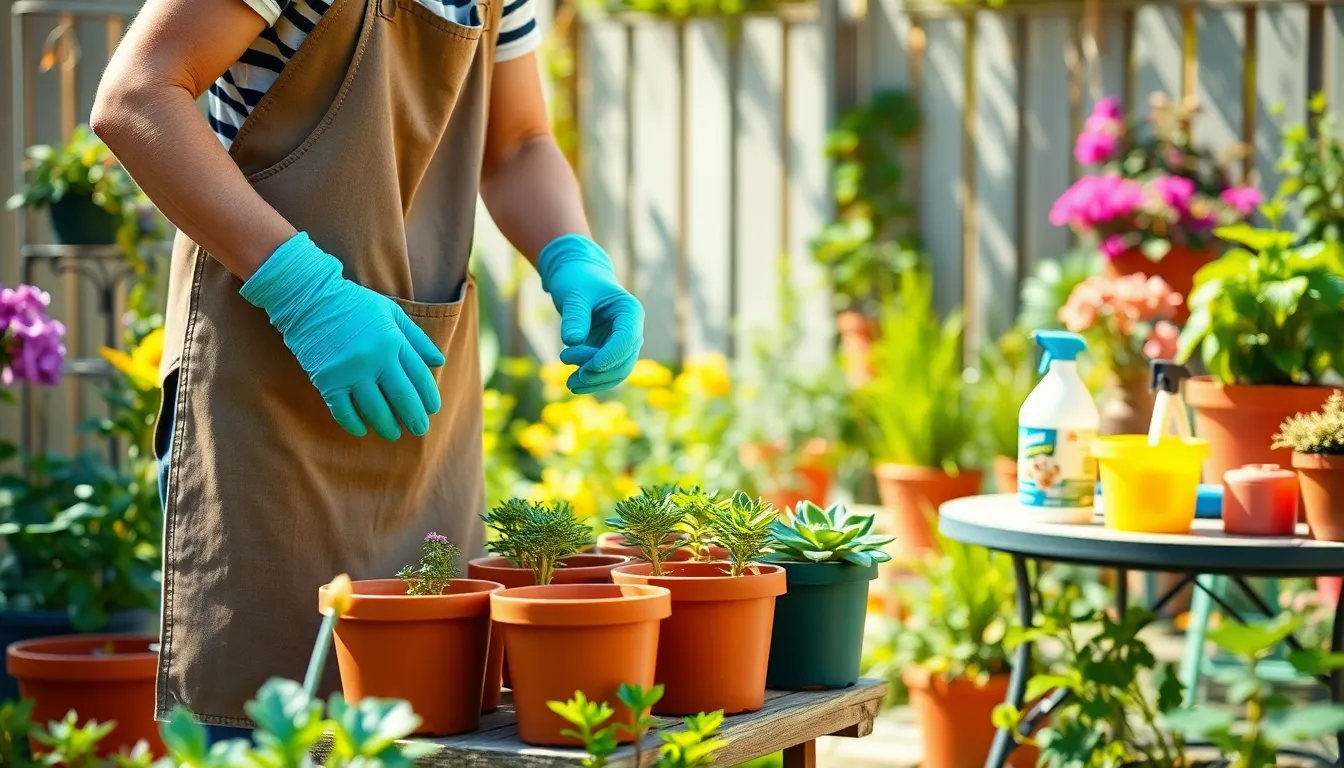
While recycled containers offer excellent eco-friendly planting answers, we must prioritize safety to protect both our plants and ourselves from potential hazards.
Avoiding Toxic Materials
Toxic residues can lurk in recycled containers depending on their previous use or plastic composition. Most plant pots contain plastics like polypropylene (#5), polyethylene (#2), or polystyrene (#6), but containers that previously held hazardous materials pose important contamination risks.
We should avoid using any container that may have stored pesticides, cleaning chemicals, or industrial substances. Chemical residues from these materials can leach into soil and be absorbed by plants, potentially causing harm to both the plant and anyone consuming its produce.
Thorough cleaning becomes essential when we’re uncertain about a container’s history. Scrub away all visible residue, rinse with mild soap, and inspect for any lingering chemical odors before repurposing containers for plant use.
Ensuring Food-Safe Containers for Edibles
Food safety standards don’t apply to all recycled containers, making careful selection crucial when growing edible plants. Containers originally intended for non-food purposes may contain materials or residues that aren’t safe for food production.
We recommend using only containers explicitly marked as food-safe or those that previously held food products. Yogurt containers, food storage bins, and similar items typically meet safety standards for growing herbs and vegetables.
Garden centers and nurseries provide reliable sources for recycled pots when we’re unsure about container safety. These establishments often clean and verify their containers before resale, giving us confidence in their safety for edible plant production.
Checking for Chemical Residues
Chemical residues like pesticides, herbicides, and mineral salts can remain in reused containers long after their initial use. These substances create ongoing contamination risks that can harm new plants or pose health hazards to gardeners and their families.
Disease-causing fungi and salt buildup present additional concerns in previously used containers. Salt accumulation can damage plant roots, while fungal spores can spread diseases to healthy plants in our recycled container garden.
Proper cleaning and disinfecting eliminates most contamination risks from recycled containers. Start by scrubbing off all soil remnants, then rinse thoroughly with mild soap or garden-safe disinfectants to remove chemical traces and biological contaminants.
We should inspect containers for stubborn stains or odors that might indicate persistent chemical residues. When in doubt, it’s better to choose a different container than risk plant health or food safety with questionable recycled pots.
Maintenance and Care for Recycled Pots for Plants
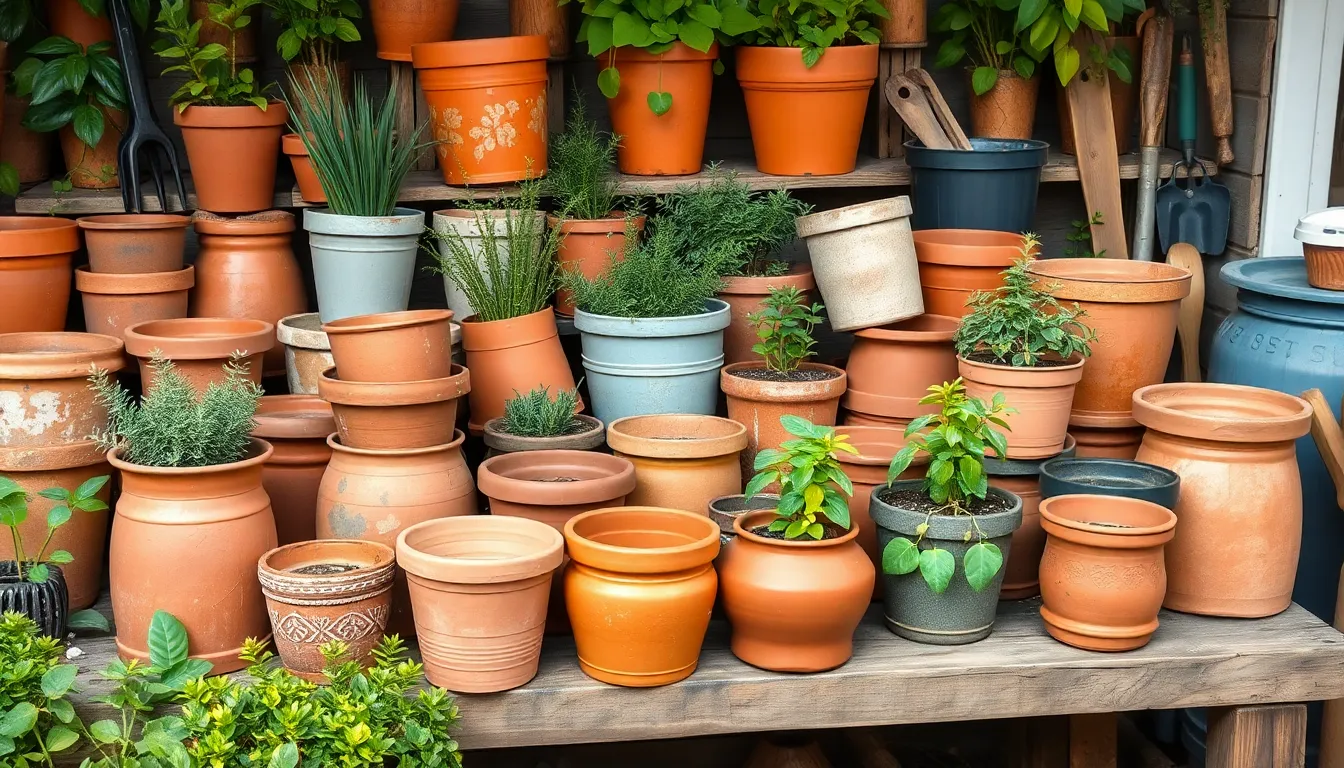
Proper maintenance ensures our recycled planters remain healthy environments for plant growth while maximizing their lifespan. We’ll extend the usability of these sustainable containers through consistent care practices.
Regular Cleaning Schedules
Establish cleaning routines between plantings to prevent harmful buildup that threatens plant health. Salt deposits, bacteria, and pathogens accumulate in used containers and create toxic environments for new plants.
Remove debris first using a stiff brush and clean water to scrub away visible residues. We should focus on eliminating mineral deposits that form white crusty layers on pot surfaces.
Apply disinfecting answers by mixing one part bleach with nine or ten parts water for effective sanitization. Soaking pots in this solution for approximately 10 minutes kills bacteria and harmful microorganisms.
Rinse thoroughly afterward to eliminate bleach residue that could damage plant roots. Sun drying provides additional antimicrobial benefits by naturally destroying remaining pathogens.
Flush porous materials like terracotta require extra water soaking after bleach treatment to remove chemicals from the material’s structure. Alternative cleaning methods include dish soap and vinegar mixtures that effectively remove dirt and mildew without harsh chemicals.
Monitoring for Wear and Tear
Inspect containers regularly for structural damage that compromises plant safety and container integrity. Cracks, chips, and material degradation signal potential problems requiring immediate attention.
Check ceramic and terracotta pots especially carefully since damage in these materials harbors bacteria more readily than other container types. Small fractures can expand over time and disrupt healthy root development.
Examine plastic containers for UV damage, brittleness, or warping that affects their structural stability. Weather exposure causes plastic degradation that weakens container walls.
Assess drainage functionality during routine inspections to ensure holes remain clear and properly sized. Blocked drainage creates waterlogged conditions that promote root rot and plant disease.
Replacing When Necessary
Replace damaged containers when cleaning can’t restore their safety and functionality for plant growth. Important cracks, persistent contamination, or structural weakness warrant immediate replacement.
Dispose of broken pots safely by wrapping ceramic and terracotta pieces in newspaper or plastic bags before discarding. Sharp fragments pose injury risks and require careful handling during disposal.
Separate recyclable materials since plastic pots might qualify for local recycling programs if clean and accepted by facilities. Most ceramic and terracotta containers aren’t recyclable through curbside programs and belong in regular garbage collection.
Time replacements strategically to coincide with repotting schedules or seasonal planting changes. Planning ahead prevents emergency situations that disrupt plant care routines.
Where to Find Materials for Recycled Pots for Plants
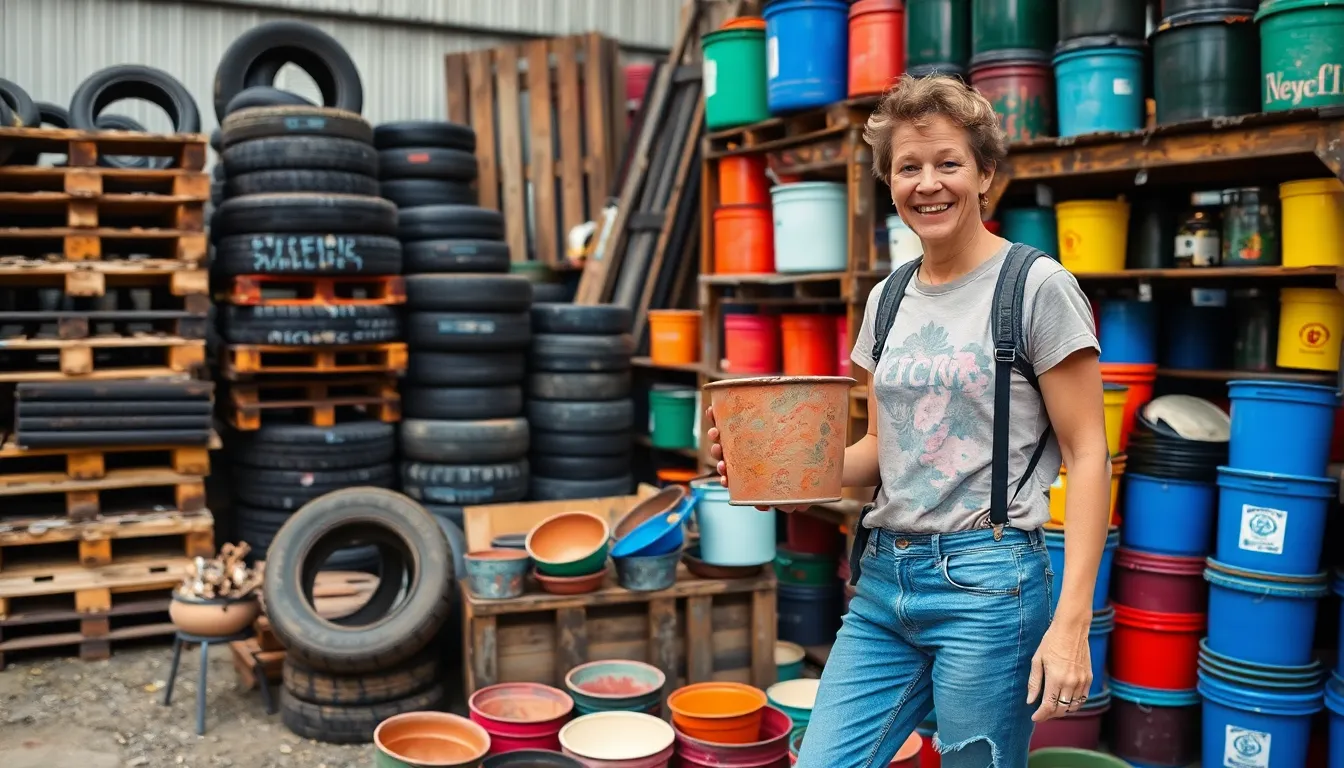
Finding materials for our recycled planter projects doesn’t require a treasure hunt. We can discover perfect containers right in our homes and local communities.
Household Items to Repurpose
Old tires become striking large planters when painted and positioned strategically around our gardens, saving disposal costs while adding unique style to outdoor spaces. Wood pallets and lumber scraps offer excellent opportunities for building custom planter boxes and vertical gardens, with many hardware stores providing these materials free of charge.
Buckets, furniture parts, crates, and barrels transform into various sized planters with minimal modification, giving our gardens an eclectic personality. Fabric scraps can be sewn into soft planters or protective liners, extending their usefulness beyond traditional applications.
Recycled paper and cardboard materials shape into biodegradable pots that break down naturally once planted in soil, eliminating the need for transplant removal. We’ll find endless possibilities by examining items we might typically discard, from old boots to kitchen colanders.
Community Recycling Centers
Local recycling centers frequently stock materials like scrap wood, plastic tubs, and metal containers at no cost or minimal fees, making them goldmines for DIY planter enthusiasts. These facilities provide access to unusual materials in bulk quantities that we wouldn’t normally find elsewhere.
Center staff often segregate materials by type, making our selection process more efficient and organized. We can schedule regular visits to these locations since inventory changes frequently based on community donations.
Building relationships with recycling center personnel helps us learn about new arrivals and special collections that might benefit our gardening projects.
Thrift Stores and Garage Sales
Thrift shops offer affordable and quirky containers such as old teapots, decorative bowls, and vintage dishes that make charming plant holders. Garage sales present opportunities to negotiate prices on discarded furniture pieces that can be converted into unique planters.
Vintage containers and baskets found at these locations add character to our garden displays while supporting reuse economies. We’re reducing landfill waste by giving these items new purpose as plant containers.
Weekend browsing at multiple locations increases our chances of discovering the perfect pieces for exact plants or garden themes. Shopping these venues allows us to find one of a kind items that reflect our personal gardening style.
Conclusion
We’ve discovered that recycled pots offer an incredible opportunity to merge our passion for gardening with our commitment to environmental stewardship. By repurposing everyday items into functional planters we’re not only reducing waste but also creating unique garden displays that reflect our personal style.
The journey from trash to treasure doesn’t require extensive expertise or expensive tools. With basic preparation techniques and safety awareness we can transform virtually any container into a thriving home for our plants.
Whether we’re growing herbs in tin cans or nurturing succulents in glass jars recycled pots prove that sustainable gardening is both accessible and rewarding. We encourage you to start your own recycled pot project today – your plants and the planet will thank you for it.
Frequently Asked Questions
What materials can I use to make recycled plant pots?
You can use various materials including plastic containers and bottles, tin cans, metal containers, cardboard boxes, paper products, glass jars, and bottles. Household items like old tires, wood pallets, buckets, and fabric scraps also work well. The key is ensuring the material is safe for plants and can be modified with proper drainage holes.
Are recycled pots safe for growing edible plants?
Yes, but only if you use food-safe containers. Avoid containers that previously held pesticides, industrial chemicals, or toxic substances. Thoroughly clean all containers before use and choose items that originally contained food products when growing herbs, vegetables, or other edibles to ensure safety.
How do I prepare recycled containers for planting?
Clean containers thoroughly with soap and water, then sanitize with a diluted bleach solution. Create drainage holes in the bottom using a drill or nail. Check that the container size matches your plant’s root space requirements. Remove any labels or adhesive residue before planting.
What plants grow best in recycled pots?
Herbs like basil and mint, small vegetables such as cherry tomatoes, succulents, cacti, and indoor flowering plants like marigolds and petunias thrive in recycled containers. Choose plants that match your container size and drainage capabilities. Biodegradable containers work well for seedlings and starter plants.
How do I maintain recycled plant pots?
Establish regular cleaning schedules to prevent buildup of debris and mineral deposits. Inspect containers regularly for structural damage, cracks, or compromised drainage. Clean with mild soap and disinfect periodically. Replace damaged containers when necessary, timing replacements with your plant’s repotting schedule for best results.
Where can I find materials for recycled planters?
Check your household items first, including old containers, buckets, and fabric scraps. Visit community recycling centers for free materials, browse thrift stores and garage sales for unique containers, and ask neighbors for items they’re discarding. Many suitable materials are readily available in your immediate environment.
Do recycled pots provide good drainage for plants?
Recycled pots can provide excellent drainage when properly prepared. You must create drainage holes in containers that don’t have them. Use a drill, nail, or sharp tool to make several holes in the bottom. Proper drainage is essential to prevent root rot and ensure healthy plant growth.
Are there any containers I should avoid using?
Avoid containers that previously held toxic substances, pesticides, industrial chemicals, or automotive fluids. Don’t use containers with unknown contents or those that can’t be thoroughly cleaned. Also avoid materials that may leach harmful chemicals into soil, especially when growing edible plants.

